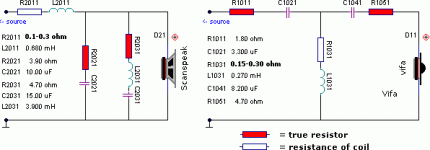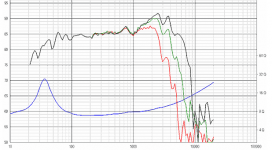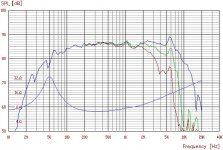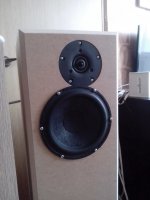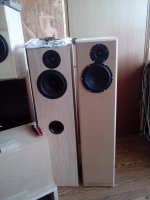Hi pmchoong,
it's a very good driver for TL (quarter wave) or bass reflex (BR).
If you aren't a noobie I would go and make a start here
Vifa PL14WJ-
The high frequency section wouldn't probably need alterations. (Attenuation as usual is always needed.)
The low frequencies would work in a ported box ~53L/22Hz tunned.
The filter for the low pass would be a different concept.
The peak of the woofer @2k5 needs to be addressed in the design. Both woofers are 86 dB sensitivity (2.83V/1m) and 5R8 DC resistance (Re).
Have fun.
Scanspeak Classic 18W/8535-00 7"
http://www.scan-speak.dk/datasheet/pdf/18w-8535-00.pdf
Vifa XT25TG30-04
http://www.tymphany.com/files/XT25TG30-04 Rev1_0.pdf
it's a very good driver for TL (quarter wave) or bass reflex (BR).
If you aren't a noobie I would go and make a start here
Vifa PL14WJ-
The high frequency section wouldn't probably need alterations. (Attenuation as usual is always needed.)
The low frequencies would work in a ported box ~53L/22Hz tunned.
The filter for the low pass would be a different concept.
The peak of the woofer @2k5 needs to be addressed in the design. Both woofers are 86 dB sensitivity (2.83V/1m) and 5R8 DC resistance (Re).
Have fun.
Scanspeak Classic 18W/8535-00 7"
http://www.scan-speak.dk/datasheet/pdf/18w-8535-00.pdf
Vifa XT25TG30-04
http://www.tymphany.com/files/XT25TG30-04 Rev1_0.pdf
Last edited:
Hi,
Thanks, Inductor.
Between the Vifa's PL14WJ-09-08 and the Scanspeak 18W/8535-00, I can see some similarities in sensitivity, Qts, Qms and Qes, thought I do not know what are these. I know nuts about designing a Xover.
I have 2 of the scanspeak drivers which are from my 2.5 clones (sibilance is sometimes unbearable so I decided to dismantled them) and a vifa 25tg. It seems that Troel isn't very fond of the 18W/8535.
Attached is the Xover taken from Troel's website (I hope he don't mind). Which part of the scanspeak xover do you think I should change? I will keep the XT25's xover section.
Thanks again.
Thanks, Inductor.
Between the Vifa's PL14WJ-09-08 and the Scanspeak 18W/8535-00, I can see some similarities in sensitivity, Qts, Qms and Qes, thought I do not know what are these. I know nuts about designing a Xover.
I have 2 of the scanspeak drivers which are from my 2.5 clones (sibilance is sometimes unbearable so I decided to dismantled them) and a vifa 25tg. It seems that Troel isn't very fond of the 18W/8535.
Attached is the Xover taken from Troel's website (I hope he don't mind). Which part of the scanspeak xover do you think I should change? I will keep the XT25's xover section.
Thanks again.
Attachments
If you don't know how to measure drivers and design a crossover, I wouldn't try to modify some crossover designed for another driver.
I found a long paper about the 2.5 clone, in which there is also an alternate crossover for a SS 9500 tweeter (pag 28): http://www.audiokit.it/ITAENG/Altoparlanti/ScanSpeak/The%202.5%20clone%20paper.pdf
If you don't find another reputable design with a 18W8535 I would opt for the 18W8535+9500.
Ralf
I found a long paper about the 2.5 clone, in which there is also an alternate crossover for a SS 9500 tweeter (pag 28): http://www.audiokit.it/ITAENG/Altoparlanti/ScanSpeak/The%202.5%20clone%20paper.pdf
If you don't find another reputable design with a 18W8535 I would opt for the 18W8535+9500.
Ralf
Thanks Ralf,
I did even modified the tweeter according to Troels's 2.5 clone paper. The 9500 costs a bomb and I do not intend to spend so much. I was hoping that someone have already done a 18w/8535 and the XT25TG combi and I'll just follow their xover. Any suggestions in the xover for the 18w/8535 and the XT25TG combi is much appreciated. Thanks.
I did even modified the tweeter according to Troels's 2.5 clone paper. The 9500 costs a bomb and I do not intend to spend so much. I was hoping that someone have already done a 18w/8535 and the XT25TG combi and I'll just follow their xover. Any suggestions in the xover for the 18w/8535 and the XT25TG combi is much appreciated. Thanks.
I respect very much (giralfino) Ralf opinion for you pmchoong, it's very wise, besides the combo (2.5 clone with the ProAc sound) was one of the most considered in the world with the 3/4" tweeter.
Scan-speak D2010-851300
After saying that, and if I was like experimenting as you mention, then I would just add the LCR notch filter for the taming of the peak. The problem is that you are using a testing/failing like approach what may take you a long time of testing to come to a good definitive smooth output response at crossover frequency.
Read here for your musings...

Important: Notice the 4 graphs for 4 different inductors for the 8535 driver on pag. 3 and how the lowest 0.27 mH inductor would be very close with no notch.
"8535 with 0.83, 0.68, 0.47 and 0.27 mH inductor value of 2nd inductor in LP section", on Fig. 5.
Again, look how playing with C1 plays an important role for the final curve on Fig 6.
Scan-speak D2010-851300
After saying that, and if I was like experimenting as you mention, then I would just add the LCR notch filter for the taming of the peak. The problem is that you are using a testing/failing like approach what may take you a long time of testing to come to a good definitive smooth output response at crossover frequency.
Read here for your musings...
Pag. 3 Measurements on LP-section, inductor L2 values:
Fig 4. Initial measurements of 8535 with 0.83, 0.68, 0.47 and 0.27 mH inductor value of 2nd inductor in LP section.
Not much chance of getting rid of the 2 kHz bump without a LCR circuit. I does strike me however that that lowest value gives a response closer to the Stereophile measurements. Making the textbook LP crossover the response is 40dB down at 7 kHz where the target seems to more like 40 dB down at 9 kHz.
For the time being I stayed with the 0.83 mH. The 300-1500 Hz response is rather smooth which pleases me a lot.
Pag. 4 ...
Pag. 5 Construction of notch filter for the 2 KHz bump:
A LCR notch filter was designed to smooth the frequency response between 1500 and 3000 Hz consisting of
1.5mH(0R35)+3.3 uF+10 ohm resistor.
Fig. 9 displays the impact on 8535 response, MLS with no smoothing.
Fig.9. LP section +/- LCR and full range response with LCR.
Notice that crossover target is only slightly affected and can easily be adjusted with C1. Fig.5.
Pag. 6 LCR impact on full range response
Fig.10. Full range response +/- LCR, 0.33 oct. smoothing.
Fig. 11. Full range response + LCR, same and reverse polarity (no smoothing). 1 meter distance, tweeter height.
Pag. 7 Significance of LCR on cumulative spectral decay.
Fig.12. 20 dB range CSD, without notch filter.
Fig.13. 20 dB range CSD, with notch filter.
The impact of the notch filter speaks for itself. With the LCR circuit in place an impressive + 1 dB frequency response is achieved between 300 and 4000 Hz, and the lack of the 2 kHz bump is clearly audible, where especially female voices gets a natural balance and acoustic guitars which may sound almost too good with the bump, now are presented with a much more realistic timbre. Listening to pink noise on the 8535 +/- LCR filter strongly suggests we get rid of the bump. Read Lynn Olson (Ariel) on the use of pink noise! (aloha-audio.com/Arieltxt2)
And best of all, the 8535 does not loose its fresh and crisp presentation. The sound of the 8535 is hard to describe (isn’t sound always?), but certainly this is a very lucky/clever combination of the right matrix of paper pulp and carbon fiber, the right cone size and weight (the cone is more flexible that the 8545), voice coil dimensions, magnet size, all giving a smooth roll off characteristic and simplifying crossover design.
(linked on post #4)
ProAc Response 2.5 loudspeaker | Stereophile.comAnd here are the MLS measurements from the Stereophile magazine, as a target for designing the crossover.
Fig 2: Stereophile measurements.
I was excited to see if the 2 kHz bump would appear as predicted from Al.M’s writing at geocities.com/diyproac25/.
The bump came out beautifully as seen from the graphs on page 2!
Pag. 2 above llink
Important: Notice the 4 graphs for 4 different inductors for the 8535 driver on pag. 3 and how the lowest 0.27 mH inductor would be very close with no notch.
"8535 with 0.83, 0.68, 0.47 and 0.27 mH inductor value of 2nd inductor in LP section", on Fig. 5.
Again, look how playing with C1 plays an important role for the final curve on Fig 6.
...this capacitor plays an important role in determining frequency response.
Last edited:
I would say with the 3rd order new crossover for the woofer, from the ProAC 2.5 clone, you're in business. Just turn on the music, and start building those boxes... and have fun. 
By the way the real ProAc Response 2.5 has no notch as I suspected.
C1=8.5uF
L1=1.5mH + 47R/5W
L2=0.83mH
No inversion of the tweeter connections, as in Troels crossover (Vifa PL14WJ-09-08 + XT25TG-30-04), but you can also test this later.
By the way the real ProAc Response 2.5 has no notch as I suspected.
C1=8.5uF
L1=1.5mH + 47R/5W
L2=0.83mH
No inversion of the tweeter connections, as in Troels crossover (Vifa PL14WJ-09-08 + XT25TG-30-04), but you can also test this later.
Last edited:
Between the Vifa's PL14WJ-09-08 and the Scanspeak 18W/8535-00, I can see some similarities in sensitivity, Qts, Qms and Qes, thought I do not know what are these. I know nuts about designing a Xover.
I have 2 of the scanspeak drivers which are from my 2.5 clones (sibilance is sometimes unbearable so I decided to dismantled them) and a vifa 25tg. It seems that Troel isn't very fond of the 18W/8535.
Attached is the Xover taken from Troel's website (I hope he don't mind). Which part of the scanspeak xover do you think I should change? I will keep the XT25's xover section.
No way. Look at the 8535 response chart below. The woofer demands very low crossover point. Only expensive tweeters can go low enough to match with the woofer.
The PL14+XT has very high crossover point. XT25 doesn't sound good at low frequency crossover so you're in trouble.
Show us your previous 2.5 clone crossover. Sibilance comes from tweeter's crossover mistake, most probably directly from notch filter. Who knows somebody familiar with the tweeter know how to fix it (by not using textbook notch filter).
If you don't know about crossover, my recommendation is to use active crossover. You don't need the complex skill of passive speaker building.
With active you can cross at very steep slope (so crossover frequency can be chosen lower than passive) and you can even equalize any peak easily.
The 8535 seems to have strength at low frequency response so deserve a keep if the limitation is understood. Three-way passive is my choice in such situation, but you don't know about crossover so the active approach is my suggestion.
Attachments
Scary...No way. Look at the 8535 response chart below. The woofer demands very low crossover point. Only expensive tweeters can go low enough to match with the woofer.
The PL14+XT has very high crossover point. XT25 doesn't sound good at low frequency crossover so you're in trouble.
Show us your previous 2.5 clone crossover. Sibilance comes from tweeter's crossover mistake, most probably directly from notch filter. Who knows somebody familiar with the tweeter know how to fix it (by not using textbook notch filter).
If you don't know about crossover, my recommendation is to use active crossover. You don't need the complex skill of passive speaker building.
With active you can cross at very steep slope (so crossover frequency can be chosen lower than passive) and you can even equalize any peak easily.
The 8535 seems to have strength at low frequency response so deserve a keep if the limitation is understood. Three-way passive is my choice in such situation, but you don't know about crossover so
Not a good help, Jay....the active approach is my suggestion.
I think your picture shows the Scanspeak 18W/8535-00 frequency output, a driver that was considered one of the best in the world in the form of the ProAc Response 2.5 and shame that you could not use it in a passive crossover. The Vifa XT25TG30-04 tweeter crossed at high 3K/3K5 with a third order/fourth acoustic will have no sibilance from my point of view, but I understand is not (work) for newbie. If that happen (I know I read about the subject) was that poor design/options was helping that and you always turn to active as a way to run from more time/trouble when you don't know what you're doing. Consider that your last option. I system that doesn't run in passive you can never make it work as an active. Passive systems are superior in the sense that you are dealing with the essence and balance of the nature of the drivers not artificiality (EQ) and amp. power. I'm saying that the design with no RLC notch is better option also, not to be confused by you bringing it again to the subject. Many design choices are a tool of the person and better acoustic solutions can be achieved if not used as a lot of us know. Sometimes, and that was the case of the ProAc 2.5, peaks and roughness where a sonic advantage of the identity of the ProAc sound, against the flatness of Troels new 9500 tweeter crossover design, not a bad thing.
Last edited:
No way. Look at the 8535 response chart below. The woofer demands very low crossover point. Only expensive tweeters can go low enough to match with the woofer.
Like my Newform ribbons (long skinny planar dynamics). And I went active. I still ended up going 3-way eventually, but that was to add big subs for another octave. I put active EQ after the active crossover, just because I had the devices. Next round I might do it all digitally.
I fell in love with active crosover doing temporary PA. Yes it's lazy to just twiddle knobs, yes it can be done other ways too; but I also achieve better-sounding results with active. Less intermodulation distortion, less power wasted. Complex wiring every time I move though. YMMV.
Scary...
Not a good help, Jay.
Remember that OP does not understand crossover design. He wants a ready-made or proven design, BUT unfortunately he doesn't want to buy the expensive Scan-Speak tweeter. Yes, he wanted XT25 design IF any is available. But with such a woofer, XT25 will be a bottleneck imo, so may not be available. BUT, active crossover is doable for beginners, and most of the time they like the sound of active over passive. Of course it is not cheap either
I think your picture shows the Scanspeak 18W/8535-00 frequency output, a driver that was considered one of the best in the world in the form of the ProAc Response 2.5 and shame that you could not use it in a passive crossover.
Do yo mean the clone? I believe the original ProAc woofer has different characteristics, especially to remove the breakup at roll-off frequency. If the cone is not made from carbon fibre, I believe the ENABLE approach can solve a little by adding extra weight to the cone edge.
Yes it is hard to create sibilance from XT25. Sometimes you don't even hear it exitsThe Vifa XT25TG30-04 tweeter crossed at high 3K/3K5 with a third order/fourth acoustic will have no sibilance from my point of view, but I understand is not (work) for newbie.
You know exactly that it is the issue hereyou always turn to active as a way to run from more time/trouble when you don't know what you're doing.
I'm saying that the design with no RLC notch is better option also,
Sometimes, and that was the case of the ProAc 2.5, peaks and roughness where a sonic advantage of the identity of the ProAc sound, against the flatness of Troels new 9500 tweeter crossover design, not a bad thing.
Honestly I thought so (But not me. I'm not going to buy such driver just to listen to the clone's midrange). May be it is the nature of the carbon fiber that the breakup is not so fatiguing. And from OP report, he didn't like the SIBILANCE of his previous clone, not the breakup, so his previous clone may be fixable and is one of the option available. I really like to see the clone crossover.
Is there another report or speaker that we are talking about (by OP) that I don't know of?!And from OP report, he didn't like the SIBILANCE of his previous clone, not the breakup, so his previous clone may be fixable and is one of the option available. I really like to see the clone crossover.
Jay
I agree that some members just want a working/tested version of crossover to copy to their ongoing new project, I don't know if this is the case. Sometimes they don't bother to come back or much less to report a thank you.
Hi guys,
Thanks for helping out. I appreciated it. i prefer a passive xover.
My xover for the 2.5 clone is as attached, which is the one from Troels' paper and the modification to the tweeter as well....removing the fluid and damp the center pole. The xover is clued under the cabinet. Maybe I'll remove them and use them for the 18/8535 and XT25TG combo. I'll take a photo once I removed them.
The 18w/8535 looks similar to the Vifa PL14WJ...see graph and compare to Jay's 18/8535 in post #9.
I have since removed the tweeter D2010/8513 and used it for the Proac 1SC clone and it sounds good. No sibilance at all. I have thought of putting the XT25TG onto the 2.5 clone but the hole doesn't fit.
I'll probably made a new cabinet similar to the Vifa PL14WJ-09-08 + XT25TG-30-04 from Troels website.
Thanks again.
Thanks for helping out. I appreciated it. i prefer a passive xover.
My xover for the 2.5 clone is as attached, which is the one from Troels' paper and the modification to the tweeter as well....removing the fluid and damp the center pole. The xover is clued under the cabinet. Maybe I'll remove them and use them for the 18/8535 and XT25TG combo. I'll take a photo once I removed them.
The 18w/8535 looks similar to the Vifa PL14WJ...see graph and compare to Jay's 18/8535 in post #9.
I have since removed the tweeter D2010/8513 and used it for the Proac 1SC clone and it sounds good. No sibilance at all. I have thought of putting the XT25TG onto the 2.5 clone but the hole doesn't fit.
I'll probably made a new cabinet similar to the Vifa PL14WJ-09-08 + XT25TG-30-04 from Troels website.
Thanks again.
Attachments
I'll probably made a new cabinet similar to the Vifa PL14WJ-09-08 + XT25TG-30-04 from Troels website.
That cabinet is only 11 litres and much too small for the SS woofer.
A simpler solution would be:
Replace the tweeter of the 2.5 clones by a Seas 22TAF/G. No modification of cabinet and crossover required.
No modification of cabinet and crossover required.
Not fully correct. The face plate of the Seas should fit, but the cutout holes are probably too small and need adjustment in order to mount the tweeter.
This crossover is designed for the 2010/8513 which is a 8ohm tweeter and the 47R would drop it to about 6.9ohm. The XT25 is 4ohm that would be even under 4ohm in the 2-4Khz range. Also, the single 47R shunt resistor will be very far away of taming the peak at Fs. You`re going for a high order topology, which is good in this case, but you`ll achieve an acoustic LR4 at around 1.5Khz and below, I think that the peak might become audible. When you have your crossover in place, play a sweep 200Hz-5Khz and listen, if you hear the tweeter hissing ( I bet you will ), then you need an L-pad or a parallel RLC attached to it. I have tested both, L-pad won`t tame the resonance that much ( it could but shuntvalue will be less than 3.3ohm ). For the RLC - I have done many experiments, with the version I have values are R = 3.9, L = 1.0mH, C = 82uF. You can use a bipolar electrolytic cap and a 0.6mm wire coil with R = 0.5-0.6 and a 3.3ohm resistor to save on cash. This will flatten the peak and will make the XT25 a pretty good tweeter. I think that you could use the XT25 with a LR2 from 2.8-2.9Khz and LR4 from 2.2-2.3Khz.
Last edited:
I started the same project.Has anyone done a scan speak 18w/8535 and a Vifa XT25TG-30-04 combination?
18w/8535 + Vifa XT25TG-60-04 (two magnets)
I will make better than ProAc XO.
I did many speakers with different ring-radiator tweeters.
3rd order on tweeter hide many fine details.
Small trick is to use 2nd order + RLC filter on resonant frequency (500hz) to reduce distortions.
- Status
- This old topic is closed. If you want to reopen this topic, contact a moderator using the "Report Post" button.
- Home
- Loudspeakers
- Multi-Way
- scanspeak 18w 8535 & Vifa XT25TG-30-04
